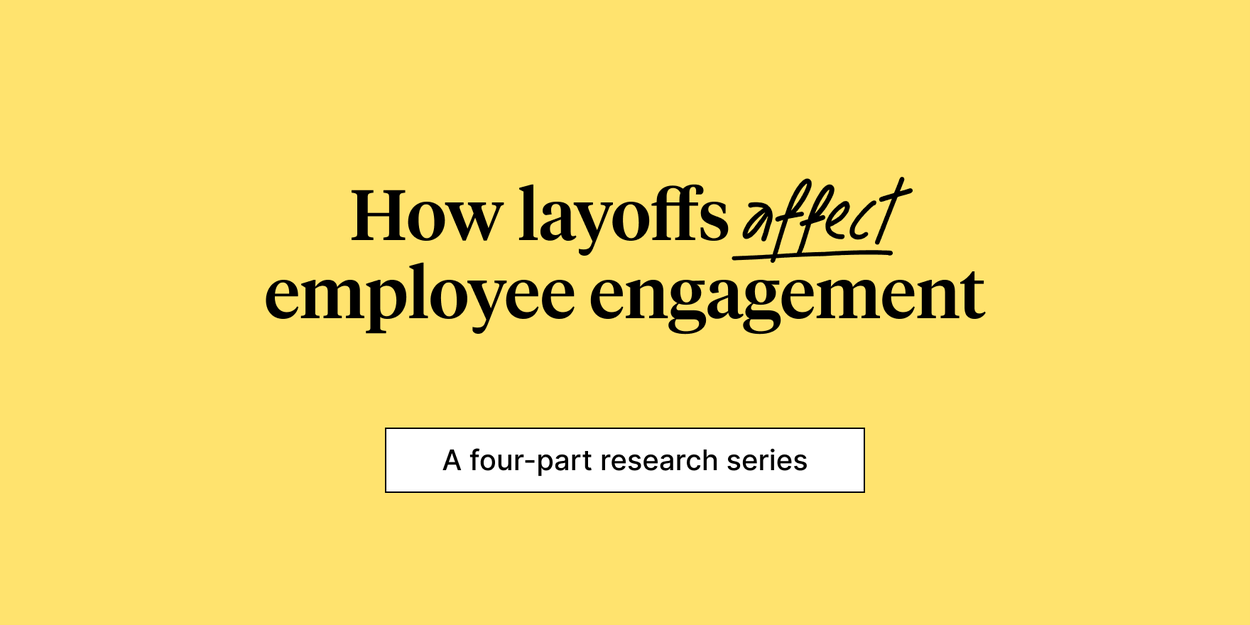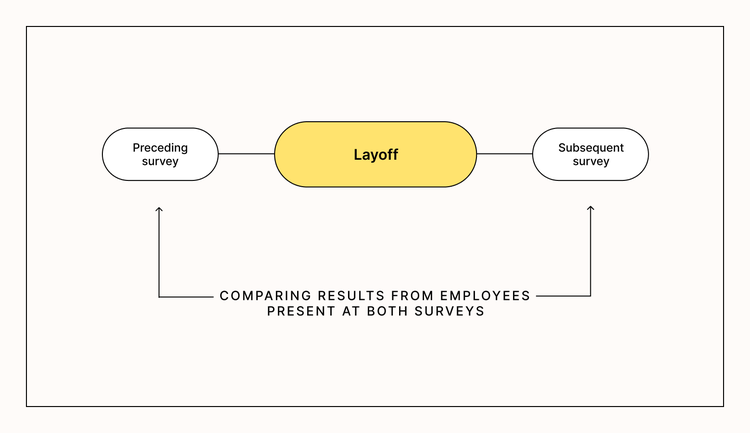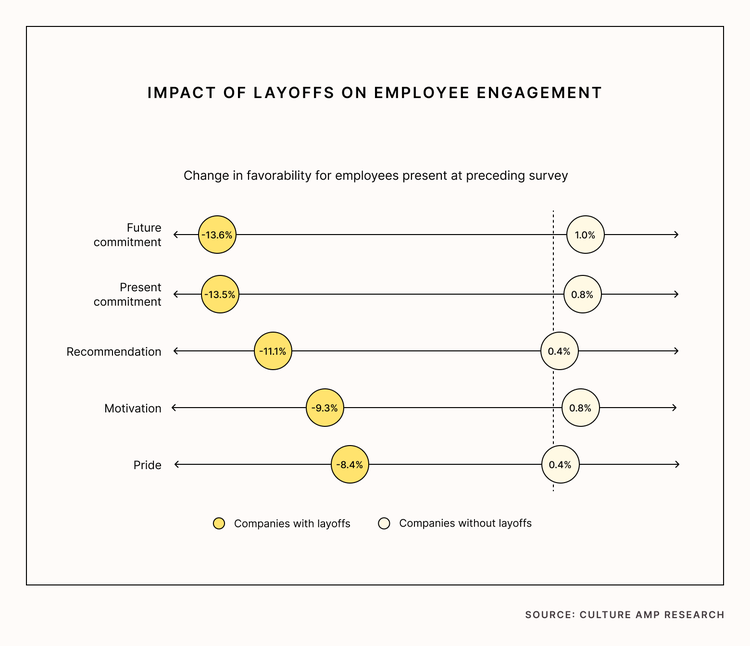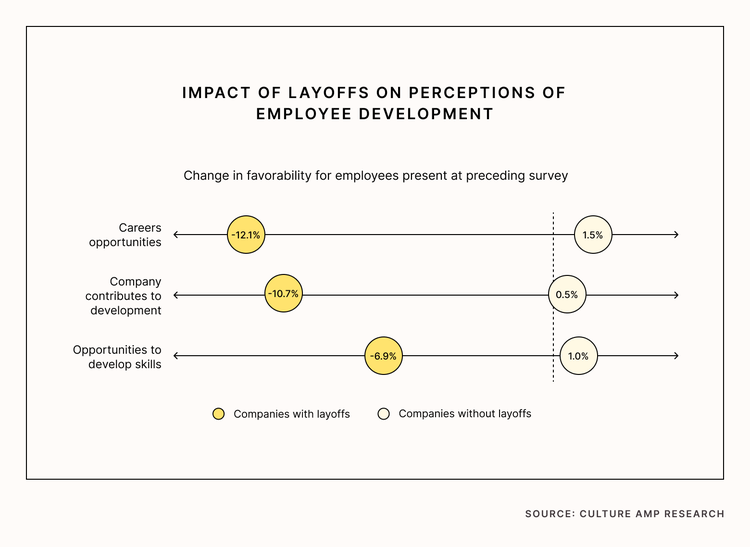
Employee engagement: What to expect after layoffs

Written by

Senior Content Marketing Manager, Culture Amp

Director of People Science Research, Culture Amp
Layoffs are never an easy decision, and the impact they have on your employees can’t be overstated.
For one thing, we know that a company’s brand and reputation can take a huge hit after a layoff. A Randstad study found that after a layoff, 70% of companies reported a negative impact on future talent acquisition efforts, and 81% reported a negative impact on the brand.
However, one area that deserves more attention is how layoffs can affect employee engagement among your remaining employees. Employee trust and morale typically plunge following any layoff, even when handled relatively compassionately. How your remaining employees feel is intrinsically intertwined with how your company will fare in the following months. This makes post-layoff employee engagement a crucial consideration, both from a culture first perspective and a longer-term business strategy perspective.
With the possibility of a recession at an all-time high, many leaders will need to consider cost-cutting measures such as hiring freezes, budget cuts, and – unfortunately – layoffs.
In the first part of our research series on rebuilding engagement in times of change, we share the latest data and insights on the impact of layoffs on employee engagement.
Our methodology
Using Layoffs.fyi, Culture Amp’s people scientists identified customers who went through layoffs between March 1, 2020, and November 30, 2022. Of these customers, 146 had conducted surveys before (Survey 1) and after (Survey 2) the layoff.

By comparing the results from the two surveys, we were able to understand some of the ways that layoffs affect employee engagement at organizations. To have a control group, we compared each company’s change to the global benchmark for the same time period. In other words, if a company with layoffs first surveyed in June 2021 and then again in December 2021, we compared them to the quarterly benchmark difference for that same time period.
Unsurprisingly, engagement takes a hit after a layoff
Just as a company’s brand and reputation are affected, you would expect employee engagement to decline, but by how much?

The largest differences are in an employee’s likelihood to recommend the company and to stay committed to the organization. This makes sense, because if an organization is in a difficult position, there are few reasons that an employee would recommend it to others. And when employees are unsure of the security of their role, they will look for a more stable role elsewhere.
The data supports this, with one study finding that even a 1% downsize can result in a 31% increase in turnover. And in some ways, choosing to leave a company after a layoff is a prudent decision on the employee’s part. In our analysis, 17% of companies in the Layoffs.fyi database went on to conduct subsequent rounds of layoffs.
Three factors driving the decline in engagement
Engagement is not something that can be acted on directly. Rather, it’s an outcome of an employee’s experience within the organization. Below, we share three insights into the factors that drive the decline in engagement following layoffs. By understanding how layoffs generally affect employees, leaders can make more informed decisions about the layoff itself, as well as take measures to mitigate the repercussions and begin rebuilding engagement.
1. Company confidence is most shaken

By far, the question with the largest decline was “[Company] is in a position to really succeed over the next three years.”
While improving long-term success is often the intent of layoffs, employees may be on to something here. Profitability studies have consistently found that the vast majority of companies that conduct layoffs “do not see improved profitability, whether measured by return on assets, return on equity, or return on sales.”
Accordingly, after going through a layoff, employees are far less likely to believe that the company is effectively directing resources or focusing on quality and improvement as a top priority.
💡How to combat this perception: Be extremely transparent and clear on how the layoffs will impact the organization's bottom line, and widely share plans to address and increase profitability.
2. Employees blame leadership

Just like boards often expect the CEO to explain and take responsibility for major changes, employees see leaders as the “culprit” or “reason” behind layoffs. Employees see leadership as responsible for making the decisions that put the company into a position where layoffs became necessary in the first place.
For that reason, layoffs dramatically affect employees’ confidence in leadership’s decision-making and the company’s overall vision for moving forward. On an individual level, employees may feel like leaders don’t appreciate their contributions or make an effort to keep them informed about the business.
💡How to combat this perception: There’s a misconception that leadership “escapes” layoffs unscathed while employees bear the brunt of the decision. To dispel this perception, share with employees the sacrifices leaders make, such as pay cuts and increased hours, so they know they aren’t the only ones struggling.
3. Employees no longer see a future career path in the organization
Our research has found that a lack of development is the #1 reason employees cite for leaving an organization. Unsurprisingly, development is also the #2 driver of engagement overall – meaning that when development is present, employees feel more positively, and when it’s absent, employees are more likely to leave.

Our data shows that following a layoff, employees fear their career opportunities will become limited, and they will no longer be able to focus on their development. This doesn’t spell a positive picture for organizations that undergo layoffs, as there is a much higher chance that employees will not only work less effectively – but also leave the company if given the opportunity.
💡How to combat this perception: While you understandably won’t be able to increase compensation for employees during this time, you can learn more about each employee’s development aspirations and reassign work accordingly.
Moreover, even if pay can’t be increased, leaders can consider continuing to give title-related promotions as a way to recognize employees’ hard work and growth. It’s also a good idea to consider “catching up” on employees’ salaries once the economy improves – and to clarify that you intend to do so.
Moving forward after layoffs
Making the decision to conduct layoffs is never easy, but sometimes it’s necessary to improve the business’s chances of weathering the economic difficulties that lie ahead. But conducting layoffs isn’t a fix-all in itself. Understanding how layoffs affect employee engagement prepares you to help your remaining employees find the motivation or trust they need to keep working in the coming months.
After a layoff, employees are far less likely to recommend others to join the company and to see themselves at the company in the future. This is not surprising, but unless adequate measures are taken to address this sentiment, there will be long-term repercussions on talent acquisition and retention.
In our research, we found that the three main factors that drive a decline in engagement following layoffs are:
- Confidence in the company
- Perception of leadership
- Feelings about employee development
Each of these are common drivers of engagement, whether or not a company has gone through layoffs. The one driver that is unique for companies that have gone through layoffs – meaning it is relatively low (ranked 67th) for all companies but high (ranked 8th) for companies with layoffs – is “I understand how my work contributes to [Company]’s mission." If you’ve had to undergo a layoff, the surviving employees want to know how their work can help right the ship.
Taking action to address these areas can go a long way in helping you repair trust and rebuild engagement in your organization in the long run.
In the next part of our series, we’ll address common myths about layoffs and share what the data reveals about these common beliefs. To ensure you don’t miss out, bookmark this page or subscribe to the People Geekly newsletter to get the latest HR insights, news, and events.

Harness the power of data to repair engagement in your workplace
Read the rest of the series:



